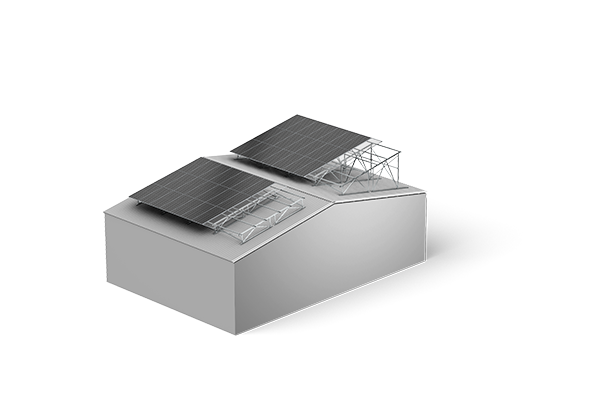How Weather Conditions Affect Solar Panel Installation on Metal Roofs
August 04, 2025
Understanding how weather conditions impact mounting solar panels on shingle roof is essential for both contractors and homeowners. Metal roofs are popular choices for solar installations due to their durability; however, various weather elements can influence the process and overall effectiveness of mounting solar panels on shingle roofs. This guide will delve into key weather factors that can affect installations and provide insight into best practices.

Temperature plays a crucial role in the installation of solar panels on metal roofs. Extreme heat can lead to expansion of the mounting materials, while cold temperatures may cause contraction. When mounting solar panels on shingle roofs, it’s important to work within a temperature range that allows for secure fastening without compromising the integrity of the roof or the solar panels. Ideally, installations should occur during mild weather, as this minimizes the risk of damage to both the roofing material and the solar panel mounts.
Additionally, hot weather can affect the efficiency of solar panels once installed. While some components are designed to handle high temperatures, excessive heat can lead to decreased electrical performance. This underscores the importance of considering local climate conditions when planning the installation of solar panels, particularly in regions experiencing extreme seasonal shifts.
Wind and rain are significant weather factors that can impact the installation of solar panels on metal roofs. High winds pose risks to safety during the installation process and can potentially cause misalignment of panels if not properly secured. When mounting solar panels on shingle roofs, it's critical to adhere to local building codes that specify wind load requirements. Proper anchor points and fastening techniques must be employed to ensure stability and minimize the risk of panel displacement during storm conditions.
Rain can also hinder installation activities, as wet surfaces can create safety hazards for installers. Moreover, moisture can potentially affect the durability of the adhesive or sealants used in the installation process. Planning installation around weather forecasts that predict dry conditions is advisable to ensure safety and maximize the quality of the installation.
Seasonal changes can affect both the timeline and method of mounting solar panels on shingle roofs. Winter installations may present challenges such as snow accumulation, which can obstruct sunlight and add weight to the roof. Conversely, summer months might provide optimal sunlight exposure but can also lead to harsh working conditions. Therefore, contractors must carefully evaluate seasonal weather patterns, allowing for flexibility in scheduling installations based on local conditions.
Moreover, understanding the long-term implications of seasonal weather on the solar panel system is essential. Ensuring proper insulation, drainage, and mounting configurations can enhance system performance throughout the year.
In summary, weather conditions significantly influence the installation of solar panels on metal roofs. By understanding the impact of temperature, wind, rain, and seasonal changes, both contractors and homeowners can make informed decisions for effective installations. As we at Antaisolar focus on providing solutions tailored to diverse environments, we remain committed to advancing the development of efficient solar energy systems while ensuring ease of installation and high performance.

Temperature Considerations
Temperature plays a crucial role in the installation of solar panels on metal roofs. Extreme heat can lead to expansion of the mounting materials, while cold temperatures may cause contraction. When mounting solar panels on shingle roofs, it’s important to work within a temperature range that allows for secure fastening without compromising the integrity of the roof or the solar panels. Ideally, installations should occur during mild weather, as this minimizes the risk of damage to both the roofing material and the solar panel mounts.
Additionally, hot weather can affect the efficiency of solar panels once installed. While some components are designed to handle high temperatures, excessive heat can lead to decreased electrical performance. This underscores the importance of considering local climate conditions when planning the installation of solar panels, particularly in regions experiencing extreme seasonal shifts.
Wind and Rain Effects
Wind and rain are significant weather factors that can impact the installation of solar panels on metal roofs. High winds pose risks to safety during the installation process and can potentially cause misalignment of panels if not properly secured. When mounting solar panels on shingle roofs, it's critical to adhere to local building codes that specify wind load requirements. Proper anchor points and fastening techniques must be employed to ensure stability and minimize the risk of panel displacement during storm conditions.
Rain can also hinder installation activities, as wet surfaces can create safety hazards for installers. Moreover, moisture can potentially affect the durability of the adhesive or sealants used in the installation process. Planning installation around weather forecasts that predict dry conditions is advisable to ensure safety and maximize the quality of the installation.
Seasonal Considerations
Seasonal changes can affect both the timeline and method of mounting solar panels on shingle roofs. Winter installations may present challenges such as snow accumulation, which can obstruct sunlight and add weight to the roof. Conversely, summer months might provide optimal sunlight exposure but can also lead to harsh working conditions. Therefore, contractors must carefully evaluate seasonal weather patterns, allowing for flexibility in scheduling installations based on local conditions.
Moreover, understanding the long-term implications of seasonal weather on the solar panel system is essential. Ensuring proper insulation, drainage, and mounting configurations can enhance system performance throughout the year.
Conclusion
In summary, weather conditions significantly influence the installation of solar panels on metal roofs. By understanding the impact of temperature, wind, rain, and seasonal changes, both contractors and homeowners can make informed decisions for effective installations. As we at Antaisolar focus on providing solutions tailored to diverse environments, we remain committed to advancing the development of efficient solar energy systems while ensuring ease of installation and high performance.
end
